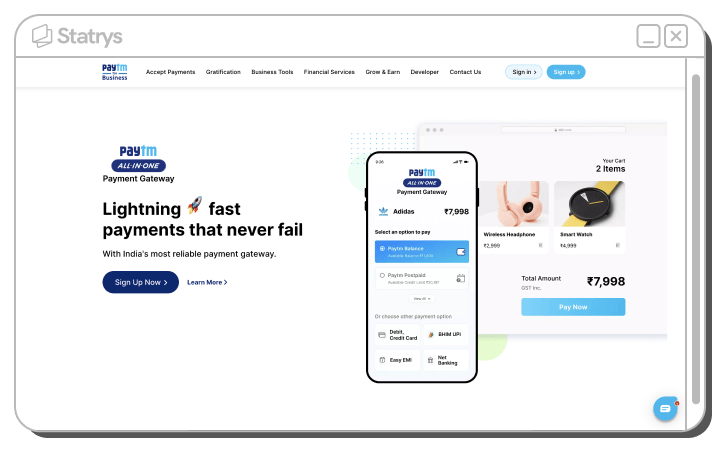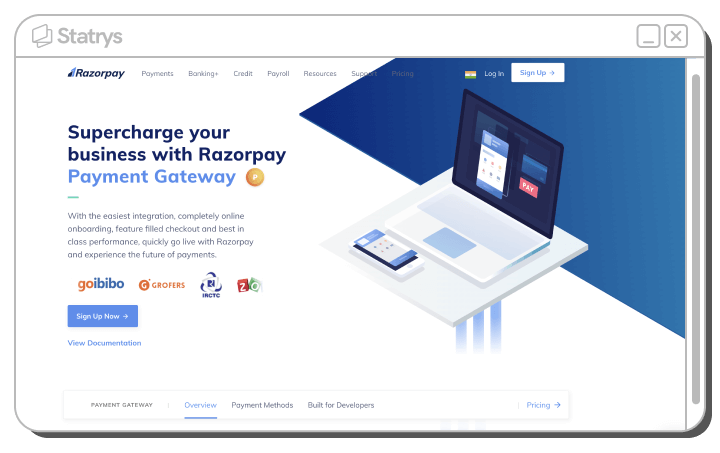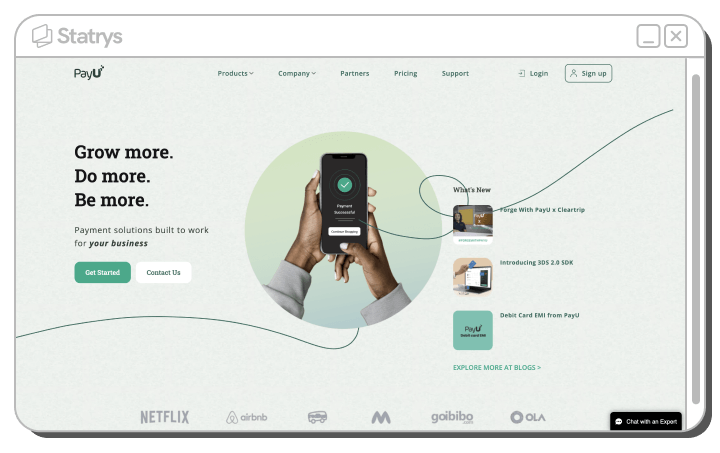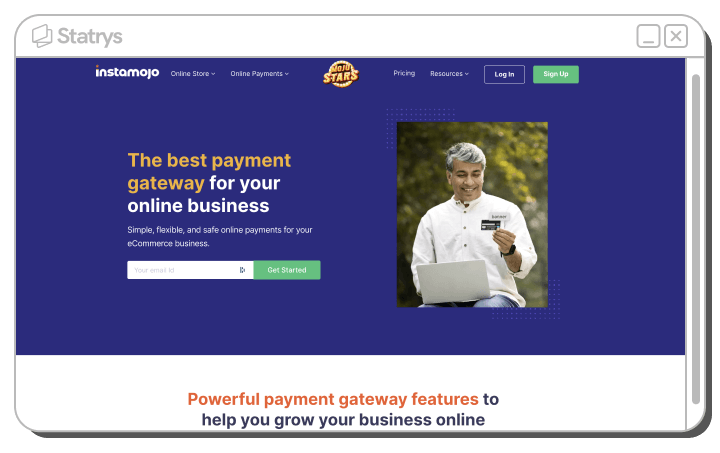India's ecommerce market is expected to grow to USD 300 billion by 2030.
As online shopping grows, digital payments are becoming more central to the process. The Unified Payments Interface (UPI) now handles over 75% of all digital transactions in India. UPI enables instant bank account transfers via apps, often linked with popular mobile wallets like Paytm, PhonePe, and Google Pay, while credit and debit card payments, including RuPay, remain widely used.
For businesses aiming to succeed in India's rapidly growing online market, selecting the right payment gateway that supports the payment methods most convenient and popular with local consumers is essential.
In this article, we've compiled a list of the best payment gateways in India, complete with their features, accepted payment options, fees, pros and cons, and factors to consider when selecting the ideal one for your business.
What Is a Payment Gateway?
A payment gateway is a platform that collects, verifies, and encrypts a customer's payment information. Once secured, it sends these details to the payment processors and the merchant's account to finalise the transaction.
However, if there are any discrepancies, the customers retain the funds. Both parties are promptly notified of the transaction outcome, ensuring the security of funds when money changes hands.

Tip: Check out our payment gateway guide and payment service provider guide for comprehensive insights into how payments work.
Overview of the Best Payment Gateways in India
Providers | Highlights | Fees |
| A widely used and established provider that can seamlessly integrate with Paytm, India's largest wallet | 1.99% - 2.99% |
| A comprehensive range of merchant services with one-click ecommerce integration | 1.50% - 3.5% |
| A suitable option for businesses with multiple locations | 1.50% - 2.99% |
| A provider that has both global connectivity and domestic coverage | 2% - 3% |
| A solution that bundles an ecommerce platform with payment services | 2% - 5% plus INR 3 fee |
Note: All information provided is subject to change and may have been updated since the time of publication. Please check each payment gateway’s website for the latest information.
1
Paytm

Paytm is a top payment app in India, with over 300 million Indians using it for everyday spending like shopping, paying bills, topping up mobiles, sending money to friends and family, and booking tickets.
It also supports businesses through its "Paytm for Business" offering payment gateways, business software, and business loans, among other services. The Paytm payment gateway is intended for small and large businesses, ecommerce, local vendors, freelancers, and more.
Over 20 million businesses use Paytm to accept digital payments. It also powers India’s biggest brands, such as IRCTC, Uber, Flipkart, Zomato, and numerous others.
Paytm Key Features
Payment Collection |
|
Default Settlement Period | Within 1 business day |
Integrations and Plugins | 30+ popular ecommerce platforms and business tools like Shopify, WooCommerce, Magento, and more. |
Unique Offering | Boost conversions by offering customers no-cost EMI, cashback, and discounts. Manage and initiate refunds. 100% online onboarding. |
APIs | APIs and SDKs for quick integration in 30 minutes |
Security | PCI DSS compliance |
Report | Real-time analytics and customisable reports |
Customer Support | Dedicated support via toll-free number and email |
International Payments Capabilities | Accept international payments in 95+ currencies, including USD, EUR, RUB, INR, GBP, and JPY, with settlements in INR. |
Paytm Accepted Payment Methods
Paytm offers over 100 payment methods, including Indians’ preferred methods, which are:
- Paytm Digital Wallet
- Paytm Postpaid
- UPI
- Debit and credit cards: Visa, Mastercard®, American Express, Diners, RuPay and more
- Bank transfer
- Net Banking from over 50 major banks
- EMI (Credit cards, debit cards and cardless)
Other payment methods may be supported upon request. The monthly transaction limit depends on the business type.
Paytm Key Usage Fees
Paytm offers two types of pricing plans for its online payment gateway: the standard pricing plan and the enterprise pricing plan. The enterprise plan is fully customisable, while the standard plan fees, designed for small to medium-sized businesses, are as follows:
- Setup fee: Free
- Annual Maintenance Charges (AMC): Free
- Platform fees for all transactions excluding Diners, American Express, and international transactions: 1.99%
- Platform fees for payment instruments: 2.99%
Please note that 18% GST is applicable on all fees. For more details, please refer to the Paytm Pricing page.
Paytm Pros and Cons

- A preferred choice for a checkout page
- Widely used in India and integrates seamlessly with Paytm’s digital wallet.

- Some payment methods, like EMI, require approval.
- Limited details on all the accepted payment methods and their transaction limits.
2
Razorpay

Razorpay is another well-known payment processing platform headquartered in Bangalore. The company provides a range of payment solutions designed for business owners, enabling them to accept, process, and distribute payments through a single provider.
While its primary service is a payment gateway, it offers various business-oriented products alongside, including developer-friendly APIs, straightforward integration solutions, payroll, business banking and more.
Razorpay has served 5 million businesses so far.
Razorpay Key Features
Payment Collection |
|
Default Settlement Period | 2 days for domestic payments and 7 days for international payments. |
Integrations and Plugins | One-click ecommerce plugins for major platforms such as Shopify, WooCommerce, Magento, PrestaShop, etc. |
Unique Offering | Create and run promotional offers to boost conversion, flash checkout features, custom UI, native OTP integration, fully online onboarding process, quick account activation |
APIs | APIs available for integration, SDKs |
Security | PCI DSS compliance |
Report | Dashboard with key statistics and real-time insights |
Customer Support | 24/7 support is available through ticket submission. You can also request to chat or receive a callback. |
International Payments Capabilities | International gateway supporting about 100 major currencies and INR settlements. |
Razorpay Accepted Payment Methods
Razorpay offers over 100 payment methods, among those are the preferred choices in India, including:
- Digital wallets - PhonePe, PayPal, Amazon Pay, PayZapp, MobiKwik, FreeCharge, and more
- UPI - PhonePe, Paytm, Google Pay, Amazon Pay, and more
- Domestic and international credit and debit cards - Visa, Mastercard®, RuPay, Maestro, American Express, Diners Club
- Net Banking from 58 banks, including ICICI, Kotak, Axis and more
- EMI (Credit cards, debit cards and cardless)
- PayLater
Razorpay Key Usage Fees
Here are the Razorpay Key Usage Fees
- Setup fee: Free
- Annual Maintenance Charges (AMC): Free
- Razorpay platform fee for all payment products: Starting at 2%
- International credit and debit card: 3%
- International bank transfers: 1.5%
- International payment methods: 3.5%
All fees are subject to 18% GST. Depending on the payment method, the monthly transaction limit ranges from INR 10,000 to INR 500,000.
Please refer to Razorpay Payment Gateway Charges for full details.

Tip: If your monthly revenue exceeds INR 5 Lakh, you may want to contact Razorpay for a possible discount.
Razorpay Pros and Cons

- Dedicated and comprehensive payment solutions designed specifically for merchants

- Some payment methods, like Cardless EMI, Bank Transfer and Pay Later, require approval.
3
Cashfree Payments

Cashfree Payments is a comprehensive payment platform in India that enables users to make and collect payments in India and abroad. It supports various payment methods and offers added features such as instant settlements, recurring payments, verification services, and cross-border payments.
Cashfree serves over 600,000 businesses, processing more than USD 80 billion annually.
Cashfree Payments Key Features
Payment Collection |
|
Default Settlement Period | Within 2 days, with options for faster settlements and instant fund access, including on bank holidays. |
Integrations and Plugins | Plugins that support Shopify, WooCommerce, Magento, PrestaShop, OpenCart, WordPress and more |
Unique Offering | Instant refunds feature, “Auto collect” features with virtual payment address and automated reconciliation built specifically for multi-branch businesses, process up to 3,000 transactions per second. |
APIs | Highly customisable APIs, SDKs |
Security | PCI DSS compliance |
Report | Centralised management with an advanced dashboard and report. Monitor and act in real-time. |
Customer Support | Get support through website queries and file complaints via email. |
International Payments Capabilities | An international payment gateway that supports transactions in over 100 currencies, with standard settlements in INR within 2 days. |
Cashfree Payments Accepted Payment Methods
Cashfree Payments offers over 120 payment methods, including
- Digital wallets - Paytm, PhonePe, PayPal, Amazon Pay and more
- UPI
- Credit and debit cards - namely Visa, Mastercard®, American Express, Diners, Maestro and RuPay.
- Net Banking of more than 65 banks
- EMI
- Pay Later
Cashfree Payments Key Usage Fees
Here are the Cashfree Payments Key Usage Fees
- Setup fee: Free
- Annual Maintenance Contract (AMC): INR 4,999
- Payment modes - UPI, Visa, Mastercard®, RuPay, PhonePe, Maestro, ICICI, Jio Money, Airtel Money, Amazon Pay, Net Banking: 1.95%
- UPI on credit cards: 2.15%
- EMI: Starting from 1.50% - 1.90%
- International cards: 2.95% - 2.99%
- Pay Later: 2.20%
Please refer to Cashfree Payments' Pricing for the complete details.

Tip: Cashfree Payments also offer custom pricing for high-volume businesses. Contact their sales and submit your questions for more information
Cashfree Payments Pros and Cons

- Unique ‘Auto Collect’ solution designed for franchisee and multi-department businesses

- Annual fees can be costly, especially when compared to other providers, which typically waive this fee.
4
PayU

PayU offers digital payment solutions to businesses in India, with over 500,000 merchants trusting its services.
The company offers a comprehensive payment ecosystem, including payment gateways, QR codes, account automation, and more. PayU also caters to industry-specific needs such as startups, travel, insurance, and edtech.
Beyond India, PayU operates under the extended brand PayU Global, serving as the payment gateway and processor for online transactions. In certain markets, it also functions as an acquiring bank.
PayU Key Features
Payment Collection |
|
Default Settlement Period | Within 2 days after the transaction. You have an option for instant priority settlements to get the fund settled faster. |
Integrations and Plugins | Plugins compatible with leading ecommerce platforms and business software, including Shopify, BigCommerce, Opencart, Wix, Zoho, and more |
Unique Offering | Multi-lingual and one-click checkout experience with native OTP, instant refunds |
APIs | APIs and lightweight SDKs |
Security | PCI DSS compliance |
Report | Detailed and downloadable report |
Customer Support | Submit queries to get answers on the website. |
International Payments Capabilities | International payments via Visa, Mastercard®, and Amex in 150+ countries, with currencies like USD, EUR, GBP, AUD, AED, SGD, BHD, NZD, and more. Settles in INR |
PayU Accepted Payment Methods
PayU India accepts over 150 payment modes, including
- Digital wallets - Paytm and more
- Credit and debit cards - Visa, Mastercard®, RuPay, American Express, and Diners
- UPI
- Net Banking
- EMI
- BNPL
PayU Key Usage Fees
PayU India has a simple pay-as-you-go plan, with 18% GST applicable on all transactions.
- Set up fee: Free
- Domestic transactions via Visa, Mastercard®, Net Banking, BNPL, wallets: 2%
- International transactions via Diners, American Express, EMI: 3%
Please refer to the PayU India Pricing page for full details.

Tip: For larger enterprises, you can contact PayU for tailored pricing.
PayU Pros and Cons

- Local and global reach
- Option for Priority Settlements to reduce transaction processing time and boost cash flow

- PayU India has limited information on accepted payment methods and transaction limits.
5
Instamojo

Instamojo is primarily recognised as an ecommerce website builder for direct-to-consumer (D2C) businesses, MSMEs and startups. However, it also offers an integrated online payments solution within the platform, allowing users to manage their online businesses with features like an in-website payment gateway, shipping, and analytics. Additionally, it provides payment solutions such as a smart page, payment links, and payouts.
The payment gateway product emphasises simplicity, flexibility, and security tailored for ecommerce. It is trusted by over 2,000,000 Indian businesses.
Instamojo Payment Key Features
Payment Collection |
|
Default Settlement Period | Default settlement within 3 business days after the transaction, with faster payout options available (instant, same-day, and next-day) for an additional fee. |
Integrations and Plugins | Easy integration with WooCommerce, Magento, and more |
Unique Offering | Get a fully customisable website that comes with a built-in payment gateway, order management and shipping integrations. |
APIs | Payment APIs and custom apps |
Security | PCI DSS compliance |
Report | A single dashboard with centralised analysis |
Customer Support | Email or request a contact back by leaving your information on the website |
International Payments Capabilities | International payment capabilities are not generally supported. However, you can contact the provider to apply. This will be subject to KYC approval. |
Instamojo Payment Accepted Payment Methods
Instamojo offers over 100 online payment methods. Among those are the following
- Digital wallets - Mobikwik, Freecharge, OlaMoney, and JioMoney
- Credit and debit cards - all major brands
- UPI
- Net Banking
Instamojo Payment Key Usage Fees
- Physical goods: 2% + INR 3
- Digital goods: 5% + INR 3
- Payment link Quick plan: 2% + INR 3 transaction fee
- Payment link Smart plan: 2% + INR 3 transaction fee, plus an annual fee of $2,999/yr
- Basic Smart Page (Landing page with integrated payments): 5% + INR 3
- Pro Smart Page (Landing page with integrated payments): 2% + INR 3 transaction fee, plus an annual fee of $9,999/yr
18% GST per transaction applies to all fees. Please refer to Instamojo Payment Gateway page and Instamojo Pricing page for full details.
Instamojo Pros and Cons

- A solution for those seeking a payment solution, or an ecommerce platform with an integrated payment solution.
- An option that prioritises simplicity

- The default settlement time is slightly longer compared to most providers.
- Not tailored for international payments; they are only offered upon request and subject to approval.
Factors to Consider When Selecting a Payment Gateway
To provide context behind our highlighted payment gateway selections and help you choose the right payment gateway for your business needs, let's outline the key factors to consider when evaluating any service provider.
Security
A secure payment takes centre stage when handling your customers' financial and personal data.
Key security measures for safe transactions include:
- End-to-end encryption to encode data between endpoints, allowing only authorised access to customers' payment details.
- Verification systems like PINs, passwords or biometrics for authentication.
- Fraud protection tools that monitor, block potential fraud, and alert relevant parties such as cardholders about unusual transactions so preventive steps can be taken if a breach is suspected.
- Compliance with PCI DSS, the security standard used by major card brands to prevent fraud and data breaches.
When evaluating providers’ security, consider asking them:
- How do you ensure data security?
- What approaches are used to counteract fraud and cyber risks?
- What is the action plan in case of a data breach?

Tip: Learn more about 11 crucial security services to protect your ecommerce website from fraud and risk
Customer Experience
Complicated checkout processes partly contribute to 70% of abandoned carts.
The simpler, faster and less cluttered you make the payment experience, the better chance of getting customers past that 70%.
Leveraging a one-click checkout page offered by many providers can be your best move. A responsive design optimised for various devices and screens will also be important since nearly 40% of customers shop on mobile. Lastly, check the success rate of a payment gateway, as it should be about 99%.
On the backend, a well-designed admin dashboard can save you time and effort in transaction management, refund processing, and reporting, improving overall operational efficiency.
To analyse a provider's user experience, ask them about their interface design specifics, such as:
- What customisation options are available?
- Does the payment page perform well on various devices, browsers, and screen sizes?
- What functionalities are included in the admin dashboard?
- What’s the uptime and the success rate of the payment gateway?
Costs
Payment gateways come with various costs, primarily transaction fees, setup fees, annual maintenance fees, international fees, and dispute fees. In India, the Goods and Services Tax (GST) is another important factor. Payment gateways are typically subject to an 18% GST, so it’s best to verify whether the provider's fees include this tax.
Furthermore, consider the pricing structure. Payment gateways typically offer two options: subscription plans with monthly fees but lower per-transaction costs or pay-as-you-go plans with no monthly fees but potentially higher cost per transaction.
In general, subscription plans are better for high-volume businesses, while pay-as-you-go suits businesses with irregular or lower sales.
To better understand costs, request a quote and ask questions such as:
- What is covered by monthly fees?
- How are international payments and foreign currencies handled? What is the exchange rate markup?
- Are extra services like fraud prevention or support charged separately?
- Are volume discounts offered?
- How will invoices be issued?

Tip: It's always a good idea to check into volume pricing options when your business starts to expand.
Compatibility
Even the most secure and feature-rich payment gateway won't add value if it cannot function within your current infrastructure. Integration with existing systems such as your website, online store, CRM software, and other essential business tools is a crucial criterion.
Common payment gateway integration options include:
- API (Application Programming Interface) to facilitate data exchange between programs and platforms.
- SDK (Software Development Kit) that allows developers to customise gateway functionality through code libraries and tools.
- Documentation guiding how to leverage tools like the API and SDK.
- Responsive technical support in case issues arise.
To evaluate a payment gateway provider's compatibility, ask about the following:
- Supported programming languages, frameworks and tools for integration.
- How are updates, upgrades, or modifications to the gateway or features managed?
Assistance
It's common to encounter payment system hiccups such as checkout crashes, fee errors, dispute issues, and refund failures, which can result in customer dissatisfaction and revenue declines.
Therefore, it’s crucial to have a provider with a responsive support team that can promptly address issues and is easily accessible through various channels such as phone, email, or live chat.
Some questions to ask about support when vetting a payment service provider include:
- What methods are available for contacting support?
- How responsive is your customer service? What’s the average response time for resolving issues?
Languages
India is home to a diverse array of languages, with Hindi having the most native speakers, 22 officially recognised, and hundreds of others spoken across the country.
So, dynamic checkout with regional languages available is a nice plus.
Final Thoughts
Doing business in India means understanding its unique payment preferences. This includes supporting digital wallets like Paytm and PhonePe, the RBI-backed UPI platforms, and major cards, including the domestic RuPay.
In addition, key factors to weigh when picking a payment gateway provider are robust security, user-friendly interfaces, seamless integrations, cost-effectiveness, and reliable customer support.
With those factors in mind, our list highlights Paytm's widespread acceptance, Razorpay's wide range of preferred payment options, Cashfree's support for multi-branch businesses, PayU's blend of local and global reach, and Instamojo's dual offering as both an ecommerce platform and payment solution.
We hope this guide helps you make an informed decision when picking the best payment solution for your business in India!
FAQs
What is a payment gateway?
A payment gateway is a bridge between the customer, payment processors and merchant account, facilitating secured fund transfers and transaction authorisations per relevant compliance standards.












